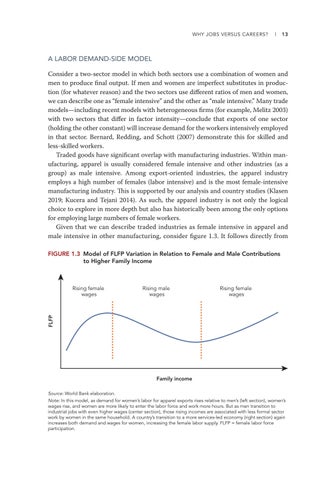Why Jobs versus Careers?
l
13
A LABOR DEMAND-SIDE MODEL Consider a two-sector model in which both sectors use a combination of women and men to produce final output. If men and women are imperfect substitutes in production (for whatever reason) and the two sectors use different ratios of men and women, we can describe one as “female intensive” and the other as “male intensive.” Many trade models—including recent models with heterogeneous firms (for example, Melitz 2003) with two sectors that differ in factor intensity—conclude that exports of one sector (holding the other constant) will increase demand for the workers intensively employed in that sector. Bernard, Redding, and Schott (2007) demonstrate this for skilled and less-skilled workers. Traded goods have significant overlap with manufacturing industries. Within manufacturing, apparel is usually considered female intensive and other industries (as a group) as male intensive. Among export-oriented industries, the apparel industry employs a high number of females (labor intensive) and is the most female-intensive manufacturing industry. This is supported by our analysis and country studies (Klasen 2019; Kucera and Tejani 2014). As such, the apparel industry is not only the logical choice to explore in more depth but also has historically been among the only options for employing large numbers of female workers. Given that we can describe traded industries as female intensive in apparel and male intensive in other manufacturing, consider figure 1.3. It follows directly from FIGURE 1.3 M odel of FLFP Variation in Relation to Female and Male Contributions to Higher Family Income
Rising male wages
Rising female wages
FLFP
Rising female wages
Family income Source: World Bank elaboration. Note: In this model, as demand for women’s labor for apparel exports rises relative to men’s (left section), women’s wages rise, and women are more likely to enter the labor force and work more hours. But as men transition to industrial jobs with even higher wages (center section), those rising incomes are associated with less formal sector work by women in the same household. A country’s transition to a more services-led economy (right section) again increases both demand and wages for women, increasing the female labor supply. FLFP = female labor force participation.


